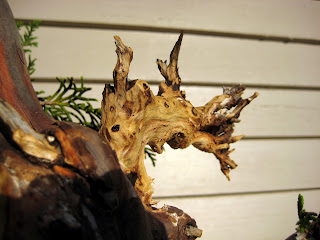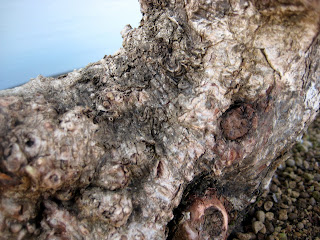I did not capture photos of the other trees from the workshop, but most were slanted without much movement in the trunk line. Dan mentioned that he was tempted to air layer many of these trees since the tops had such interesting deadwood and the many of the trunks lacked taper. The tree I chose was the only one that was relatively columnar, but yet, it seemed to have some movement in the trunk when viewing from a certain angle. Most of the four hour workshop was spent on carving using a Mikita die grinder - Dan's weapon of choice. I spent the last half hour or so wiring the foliage. Dan and I disagreed somewhat on the front, as he felt it was best to expose as many gnarled dead branches as possible, whereas, I preferred to expose the most trunk movement and taper, as seen here...
Many older trees, especially yamadori, have a main point of interest. As bonsai artists, it is our objective to first see this, but then also to accentuate and draw focus to it. This tree on the other hand seems to have many areas of interest, from its hollow trunk, to the gnarly jin at the base, which at one point was a root, to the intense dead, gnarled branches, to the beautiful array of colors seen when exposing the inner bark.
The tree seems to be adjusting fine to Nebraska, despite our very hot and humid conditions as of late. It will be interesting to see how the tree reacts to transplanting and adjusting to a less acidic soil. More photos of the convention and workshops, including some of myself and Dan working on this tree can be found here.


















